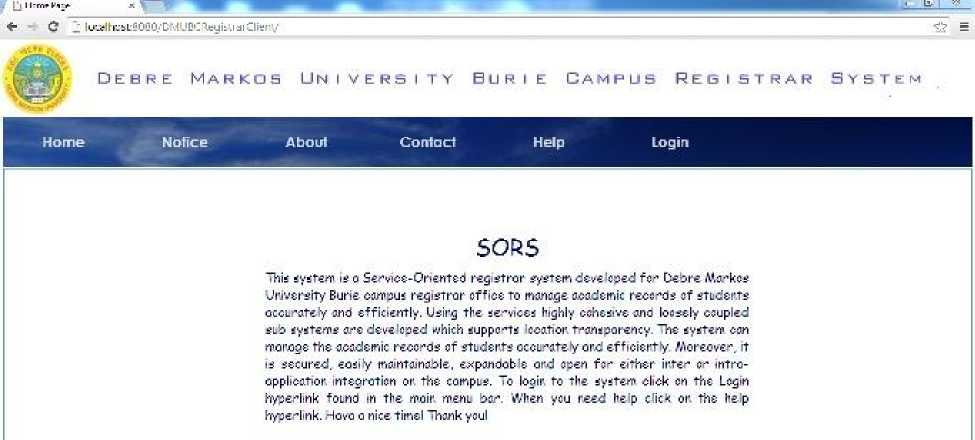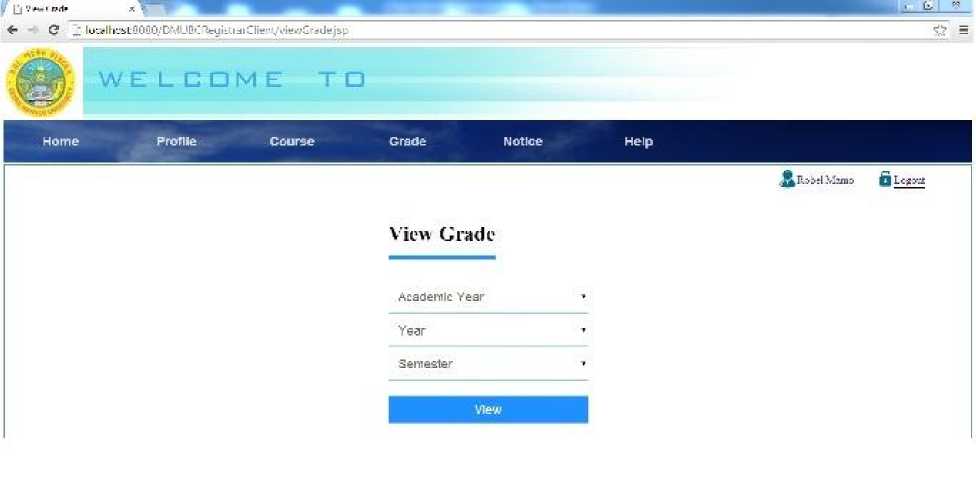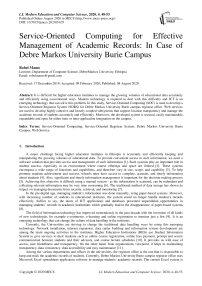Service-Oriented Computing for Effective Management of Academic Records: In Case of Debre Markos University Burie Campus
Автор: Robel Mamo
Журнал: International Journal of Modern Education and Computer Science @ijmecs
Статья в выпуске: 4 vol.12, 2020 года.
Бесплатный доступ
It is difficult for higher education institutes to manage the growing volumes of educational data accurately and efficiently using conventional ways. Modern technology is required to deal with this difficulty and ICT is an emerging technology that can solve this problem. In this study, Service-Oriented Computing (SOC) is used to develop a Service-Oriented Registrar System (SORS) for Debre Markos University Burie campus registrar office. Web services are used to develop highly cohesive and loosely coupled subsystems that support location transparency and manage the academic records of students accurately and efficiently. Moreover, the developed system is secured, easily maintainable, expandable and open for either inter or intra-application integration on the campus.
Service-Oriented Computing, Service-Oriented Registrar System, Debre Markos University Burie Campus, Web Service
Короткий адрес: https://sciup.org/15017597
IDR: 15017597 | DOI: 10.5815/ijmecs.2020.04.05
Текст научной статьи Service-Oriented Computing for Effective Management of Academic Records: In Case of Debre Markos University Burie Campus
A major challenge facing higher education institutes in Ethiopia is accurately and efficiently keeping and manipulating the growing volumes of educational data. To provide convenient access to such information, we need a software solution that provides access and management of such information [1]. Such systems play an important role in student success, especially in an environment where course offerings and space are limited [2]. These systems encompass a wide range of functions and capabilities, and therefore vary in size, scope, and capability [3]. To help promote students achievement and success, schools must have access to complete, accurate, and timely information about students [4]. Also, significant and timely information management is important for the decision-making process [5]. Achieving this objective is difficult using a manual system - as the information is scattered, can be redundant and collecting relevant information may be very time consuming [6]. The traditional method of data storage has shown its impact on managing documents from security, retrieval, and monitoring [7].
In the pre-digital age, managing student’s information was done manually, using paper-based systems. However, with increasing number of students in educational institutes, the system could no longer handle student’s records effectively. Suffice to say, the dawn of ICT applications and databases presented unparalleled opportunities in managing students’ records in academic institutions which gradually lead to the disappearance of paper-based systems [8].
The field of Information technology has improved tremendously in the past decade with the invention of all kinds of new technologies for example e-commerce, e-learning and online registration to mention just a few [9]. It is an emerging technology that can change the culture of data handling in the institutes.
Currently, the Universities are striving to change the traditional data handling ways by using this emerging technology. Network installation, internet expansion, data center building and information system development are among the main ongoing activities in the institutes. Higher Education Institutions (HEIs) use Student Information System to give services to their students such as online course registration, online fees payment, prompt and secure communication between students and their advisors, and course lecture schedules [10]. It provides us with ease of access, user friendliness and transparency. On the other hand, from organizations viewpoint, it helps in maintaining transparency, data consistency, data accessibility and easy maintenance [11].
Among the various departments and offices in the universities, the registrar office is the one that is responsible to keep and track the academic records of students. Currently, Debre Markos University Burie campus registrar office uses Microsoft Excel spreadsheet application software to manage students’ academic records. The current Excel system is better than nothing, but it has so many challenging drawbacks. Among the drawbacks accuracy, efficiency, reliability and security drawbacks are the main ones.
It is revealed that the registrar office requires a better software system for an effective management of students’ academic records. Therefore the aim of this study is to analyze, design and implement a Service-Oriented Registrar System (SORS) as per the requirements of the office.
Any college related information such as events, notifications, updating or deleting of student records could be done easily and securely using web based online system [12]. Service-Oriented Computing (SOC) is the computing paradigm that utilizes services as fundamental elements for developing applications/solutions. Services perform functions, which can be anything from simple requests to complicated business processes [13]. Multiple applications in school information systems create problems because of the lack of communication between them [14]. Services help integrate applications that were not written with the intent to be easily integrated with other distributed applications and define architectures and techniques to build new functionality while integrating existing application functionality [13].
-
2. Statement of the problem
The underlining problem that commences this study is that the existing spreadsheet registrar system is inaccurate and inefficient to keep and track of students’ academic records.
The major problems found in the existing system are as follows:
-
• It creates wrong data records like wrong calculation of students’ result and status.
-
• It creates inconsistency of data in the different sheets of the spreadsheet system.
-
• It creates redundancy of data that leads to inconsistency because it doesn’t have a database system that can solve this problem.
-
• It is complicated and time taking because it requires manually creating, searching, modifying and deleting records.
-
• It is not reliable because undesired and unseen alteration may easily happen and creates failure in the system.
-
• It doesn’t have any means that enables students to follow-up their academic records.
-
• It doesn’t have any means that enables teachers to process students’ result.
-
• It doesn’t have any means that enables departments to follow-up course information.
-
• It is not secured because data is not confidential and unauthorized user may easily access and modify it. In
-
3. Objectives
addition it is vulnerable to malicious codes.
-
A. General objective
The main objective of the study is to analyze, design andimplement a Service-Oriented Registrar System for Debre Markos University Burie campus registrar office that can effectively manage students’ academic records.
-
B. Specific objectives
To achieve the general objective, the following specific objectives are carried out.
-
• To identify and analyze the initial and extended requirements of the system.
-
• To design the system using an object-oriented paradigm.
-
• To implement the system using a service-oriented approach.
-
• To test the system from the end users perspective.
-
4. Related Literature
-
A. Service-Oriented Computing
Service-Oriented Computing allows the sharing of common application services as well as information. It also promotes reusability of a service and, as a result, significantly reduces the need for redundant application services and/or applications. Service-based applications are developed as independent sets of interacting services offering well-defined interfaces to their potential users [13].
The notation of Web services is used to implement a Service-Oriented system. Web services enable to access remote application services through a well-defined interface (Web Services Description Language, or WSDL), directory (Universal Description, Discovery and Integration, or UDDI), and transport protocol (Simple Object Access Protocol, or SOAP). The architecture for Web services provides a framework that can be fleshed out with more powerful representations and techniques taken from established computer science approaches [15].
-
B. Service-Oriented Computing Activities
-
5. Methodology
To develop a system using service-oriented computing the following activities are carried out: First, the application web services are created which make the server to be ready to respond to a SOAP request from the clients. Second, the web service clients are created which would like to invoke the services. The service descriptions of the web-services are expressed using WSDL. WSDL is a standard agreement between the clients and the server which used to publish a web service in terms of its ports, port types, and bindings [13]. Finally, clients will be able to invoke the web services residing on the server.
-
A. Design Methodology
The methodology used in this study is the Object-Oriented system development methodology. It is a software development strategy based on the idea of building systems from reusable objects. Objects are instances of classes and can be easily replaced, modified, and reused. It used to model real-world objects better than the traditional methods.
-
B. Method of Data collection
Gathering requirements is the corner stone to any successful project. Requirements are critical for scoping, defining, estimating, and managing the project. A requirement is a statement that identifies a capability, characteristic or quality factor of a system in order for it to have value and utility to the user. For effective elicitation of requirements, proper gathering techniques are required. The preferred methods of data collection used in this study are observation, interview, document analysis, and use case analysis.
-
• Observation is used to observe how the existing system works and provides service to the users.
-
• An Interview is used to gather the detail requirements of the system. Registrar and record officers are selected
for the interview.
-
• Document analysis is used to analyze the different documents (registration slips, grade submission forms, academic result reports, add and drop forms, etc) found in the office.
-
• Use case analysis is used to identify the scenarios, actors and use cases of the system.
-
C. Development tools
-
6. System Design
The system development tools used are Java Server Page (JSP) and Web Services on the server side, HTML, CSS and Java Script on the client side, MySQL database server to create the database, GlassFish server which supports Web service, Macromedia Flash and Anim-Fx to create animated effects and the Jaspersoft iReport tool to create dynamic reports to the system.
-
A. System Architecture
In this study a Service-oriented Architecture (SOA) is used to develop the system. A Service-Oriented Architecture is an architectural style whose goal is to achieve loose coupling among interacting software agents [16].
When the clients invoke the remote services it is transparent i.e. the clients don’t know that the services are executing on a different machine or vice versa. The following figure depicts the architecture of the system.

Database Server
Registrar System Database
Application Services
Fig.1. Architecture of SORS
The SORS is a client-server (request-reply) system which enables to manage the load by dividing tasks to the clients and the server machines. The clients perform data validation and the core functionalities are performed by the server.
The service oriented approach will make easy to extend the system to other functionalities in an integrated manner. Systems like dormitory system, clearance system, cost-sharing system, etc can be easily integrated with this registrar system to build a composite student information system.
-
B. User Interface Design
-
7. Advantages of the New System
Best user interfaces are visible to the user, avoid unnecessary elements and are clear in the language they use on labels and in messaging. In this study, appropriate tools are used to create consistent and common user interface elements. The system has a home page that is accessible to everyone. Then from the home page, users can click on the login hyperlink to go to the login page.

Fig.2. SORS Home page
After successful login users will be redirected to their respective page. The hyperlinks are designed in a drop down menu fashion. For example, the figure below shows the view grade page of the student user.

Fig.3. View Grade page
Accuracy: the service oriented approach creates a proper communication between the clients and the services. Data is abstracted and properly stored in the database. User inputs are properly validated and verified and system outputs are properly delivered. These lead the system to be accurate and perform what it promises.
Reliability: the system is not exposed to undesired and unseen alterations which are potential causes to failure.
Performance : the service oriented approach creates an opportunity to develop a system with highly cohesive and loosely coupled classes and this will decrease the complexity of the system and increases its performance. The Jaspersoft iReport tool also enables the system to generate dynamic reports efficiently.
Availability : the system is available in the intranet whether the internet is there or not on the campus. The system supports location transparency which enables the clients to invoke the services irrespective of their location.
Security : the system uses authentication mechanism to filter out valid users and their privilege to the system. In addition the MD5 hashing is used to secure login passwords. The users’ session is well managed in the system to safeguard their session from others.
Maintainability : the system uses highly cohesive and loosely coupled classes and this makes the system easily maintainable and expandable.
Integration : the service-oriented approach enables other services to be easily integrated to add additional features in the system.
-
8. Conclusion
In this study, Service-Oriented registrar system is developed for Debre Markos University Burie campus registrar office to manage academic records of students accurately and efficiently. Web services are used to develop the system using the service-oriented approach. Using the services highly cohesive and loosely coupled subsystems are developed which supports location transparency. The new system can manage the academic records of students accurately and efficiently. Moreover, it is secured easily maintainable and expandable. It is also open for either inter or intraapplication integration on the campus. It is recommended that adding more personal computers in the campus and developing some of the functionalities of the system using a mobile (Android) application will able to increase the accessibility of the system.
Acknowledgment
The author wishes to thank Debre Markos University Burie campus registrar office officers for providing all the relevant information.
Список литературы Service-Oriented Computing for Effective Management of Academic Records: In Case of Debre Markos University Burie Campus
- Alameri, Ibrahim & Radchenko, Gleb. (2017). Development of Student Information Management System based on Cloud Computing Platform. Journal of Applied Computer Science & Mathematics. Accepted. 11. 9-14. 10.4316/JACSM.201702001.
- Ruben Estevez Sean Rankin Ricardo Silva, (2014), A model for web-based course registration systems, International Journal of Web Information Systems, Vol. 10 Iss 1 pp. 51-64.
- Obasi Nmaju, Nwachukwu Enoch, Ugwu CHIDIEBERE. 2013/07/01, A Novel Web-Based Student Academic Records Information System VL–7, West African Journal of Industrial and Academic Research.
- Degif Teka. “School Management System”. Degree of Master of Science in Computer Science, School of Graduate Studies, Addis Ababa University, June, 2008.
- C. Gürkut and M. Nat, ‘‘Important factors affecting student information system quality and satisfaction’’. EURASIA J. Math. Sci. Technol. Educ., vol. 14, no. 3, pp. 923–930, Dec. 2017.
- Bahubali Akiwate, Ayazahmed Patel Tasleem Nabiwale, Namita Naik, Suraj Patil, “Web Based Student Information Management System using MEAN Stack” IJARCSSE Volume 6, Issue 5, May 2016.
- Caluza, Las Johansen B. "Development of Electronic Document Archive Management System (EDAMS): A Case Study of a University Registrar in the Philippines." International Journal of Digital Information and Wireless Communications, vol. 7, no. 2, 2017, p. 106+. Accessed 7 Mar. 2020.
- Symon C. Lubanga, Winner Dominic Chawinga, Felix Majawa and Sellina Kapondera. (May 2018). Web Based Student Information Management System in Universities: Experiences From Mzuzu University. Standing Conference of Eastern, Uganda.
- Pharaoh Chaka, Fungai Starben Mungadzi. An Implimentation of an Online Based Registration System In Tertiary Institutions In Zimbabwe. International Journal of Engineering Research & Technology (IJERT) Vol. 2 Issue 10, October-2013 IJERTIJERT ISSN: 2278-0181.
- Ismail, Mustapha et al. “How Student Information System Influence Students’ Trust and Satisfaction Towards the University?: An Empirical Study in a Multicultural Environment.” IEEE Access 7 (2019): 111778-111789.
- Singh, Rattan, Singh*, Ravinder, Kaur, Harpreet, and Gupta, O. P. “Development of Online Student Course Registration System” Oriental Journal Of Computer Science & Technology Vol. 9, No. (2), Pgs.66-72, August 2016.
- Manisha K, Alekhya K, T Manikanta, B Ramya, S. Sai Kumar. (March 2016). Student Information Management System. IJARCSSE, Vol.6, Issue 3.
- Papazoglou Mike, 2003/12/01, Service-Oriented Computing: Concepts, Characteristics and Directions, 10.1109/WISE.2003.1254461, Proceedings of the Fourth International Conference on Web Information Systems Engineering.
- Steenkamp and Basal (2010). Building an Integrated Student Information System in a K-12 School System. Information Systems Education Journal, Vol. 8, No. 24, ISSN: 1545-679X.
- Michael N.Huhns, Munindar P. Singh. (2005). Service-Oriented Computing: Key Concepts and Principles. 089-7801/05, IEEE Computer Society.
- Erickson John, SiauKeng. 2008/01/01, Web Services, Service-Oriented Computing, and Service-Oriented Architecture: Separating Hype from Reality. VL-19 10.4018/jdm.2008070103 JO-j. Database Manag.


